Recommended Varieties/Cultivars
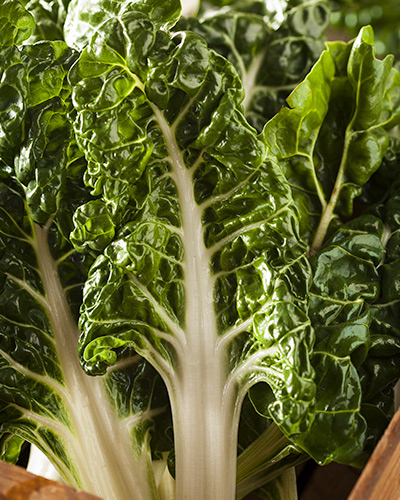
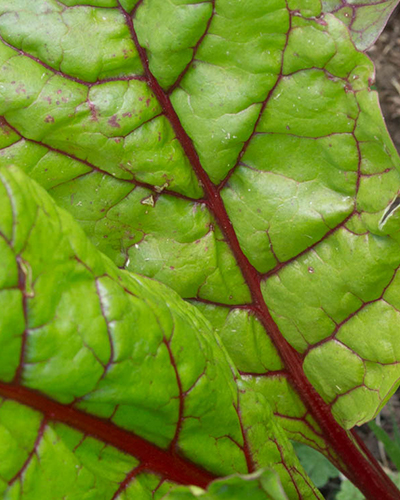
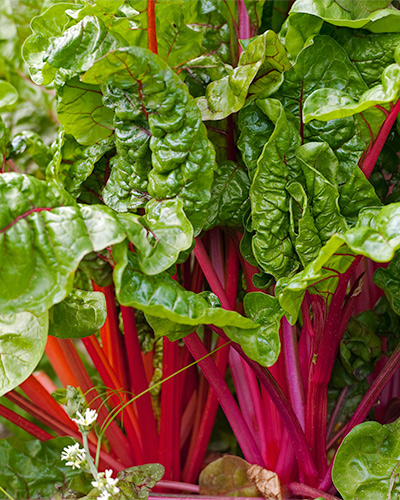
In general, green-leafed, white-stalked chard varieties produce greater yields, are more heat-tolerant, and resist bolting longer than the red and multi-colored varieties. Fordhook Giant is the stand-out chard variety for gracefully providing yields of large leaves over long periods of up to a year or two when kept well-watered and shaded during hot summers, and protected from frosts. Lucullus is another reliable green-leafed variety.
Red and other colors of chard generally produce smaller leaves, are less tolerant of both heat and cold, are more generally prone to bolting, and have shorter harvest periods than green-leafed and white-stalked varieties, but they offer the benefit of incredible beauty in your garden and on your dinner plate, and for gourmet cooks and selective gardeners, subtle differences in flavor and function for cooking. Ruby Red and Rhubarb are good choices for red chard, but tend to bolt in summer heat, winter cold, dry periods, or when temperatures are below 50°F. Bright Lights, Rainbow, and Five Color Silverbeet are popular multi-colored varieties, and add welcome bursts of reds, oranges, pinks, and purples.
Buying/Selection Tips
Purchase seeds, not seedlings. Chard should generally be seeded directly outdoors. GardenZeus recommends against purchasing chard starts for transplant, especially if rootbound or it has been more than a few weeks since germination, as starts may be more prone to poor yield, disease, pest, and other problems.
Chard can be effectively transplanted within the first few weeks after germination; this is generally recommend for skilled biointensive gardeners and experienced gardeners who are willing to monitor seedlings closely.
Soil Needs/Tip
Chard is more tolerant of difficult soils than most other leafy greens. It prefers loose, well-drained, slightly acidic soil, with a preferred pH range of approximately 6.5 to 6.8 and moderate-to-high fertility and organic matter. Chard will produce leaves with higher nutritional value in fertile soil.
Chard may underperform; be slow-growing; fail; or produce small, chlorotic, impalatable, tough, or stringy leaves and stalks in alkaline soils above 7.0 pH, in acidic soils below about 5.8 pH, or in compacted soils. Although chard does not produce a thick taproot like its alter ego, beet, it is still prone to underperforming in soils that are compacted, low in organic matter, or obstructed by stones.
Suitable Microclimate
Chard is more-resilient and less-fussy than many greens. It prefers full sun, with full shade during hot summer afternoons. In part shade, chard may not grow tall or perform well, and may produce fewer and smaller leaves. Most varieties of chard will bolt prematurely during hot weather, cold weather, or dry soil conditions. Long-lived varieties of chard, such as Fordhook Giant and Lucullus, may continue to yield leaves for 2 years or longer if shaded during hot weather and protected from frost. See GardenZeus Tips for Shading Vegetables During Hot Weather for creative ideas from GardenZeus expert Darren Butler to provide shade.
Ideal growing temperatures for chard are about 55°F to 75°F. See "Recommended Varieties/Cultivars," above, for heat-tolerant varieties that often continue yielding without bolting during hot summer temperatures. Chard seeds germinate best at warmer temperatures of 80°F to 85°F.
Getting Started
Chard is easy to grow and produces abundant yields. It may be the best green for new gardeners or those who have had difficulty growing other greens.
How many chard plants should you grow? With the chard varieties Fordhook Giant and Lucullus in particular, several plants per person may be sufficient to provide plenty of chard for steady harvest over an extended period, as long as a year or two in areas with little or no frost during winter. For almost any chard variety in fertile soil and full sun, a few to a dozen plants per person may be sufficient, even for chard lovers. You may wish to plant red and multi-colored varieties varieties of chard successively every 4 to 6 weeks. For green-leafed, white-stalked varieties, 2 to 3 new plants per family member every several weeks during your area's planting season may be sufficient to maintain a long-term, consistent yield. See Garden Oatmeal by GardenZeus expert Darren Butler for information about nutritious, productive garden greens, including chard, that may cause even the bravest of digestive tracts to falter when faced with the abundant yields from a small number of plants.
Watering Tips
Chard prefers uniform, sufficient moisture in well-drained soil. Avoid overwatering, especially in clay and heavy soils. In healthy, living soil, established chard can go long periods with minimal water. Established plants can produce well without irrigation during rainy periods. Avoid wilting as much as possible, especially moderate-to-severe wilting, as this is a primary cause of early bolting.
Planting Method/Tips
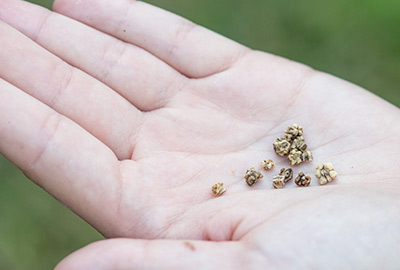
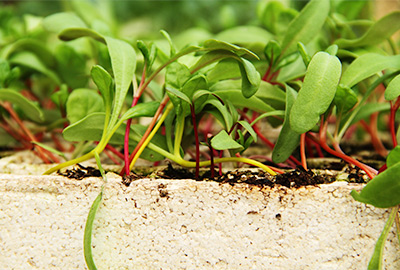
Chard seeds are large enough to plant easily by hand. It's generally best to start seeds directly outdoors.
Chard seeds are unusual in that, like beets, they are polyembryonic and can produce multiple chard plants, usually 1 to 3 per seed, but for some seeds as many as 5. It may be possible to separate and transplant extra sprouts from one seed, but generally it's best to snip off the weaker sprout(s) within about a week of germination, and grow only the single strongest sprout to maturity to avoid reduced yield due to crowding and competition for sunlight and root space. Chard should be thinned by snipping at the root crown with sharp garden scissors within 1 to 2 weeks of germination.
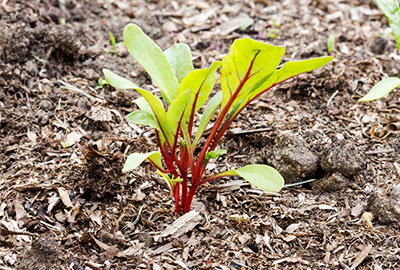
Spacing
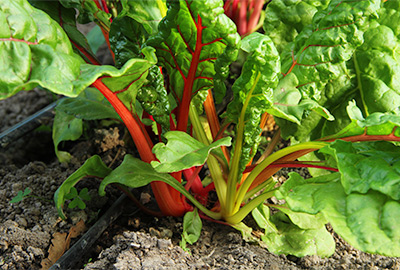
Plant chard seeds about 1/2-to-3/4-inch deep.
Chard spacing varies based on variety and your intended harvesting plan. If harvesting individual leaves or whole plants before they reach full size, GardenZeus recommends thinning to spacing of 8 to 12 inches for red and multi-colored chard varieties, and about 10 to 18 inches for green-leafed and white-stalked varieties. Chard plants can grow enormous, to a height of 4 to 5 feet or larger with a spread of at least 3 to 4 feet.
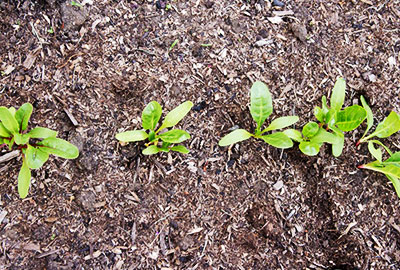
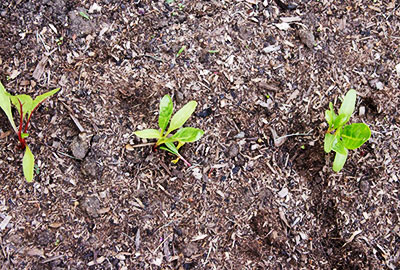
Timelines
3 to 10 days or longer to seed germination (may take 2 weeks or longer during cool weather).
1 to 2 weeks after germination to 1st thinning, retaining only the single strongest start per seed.
Transplanting is possible about 2 to 4 weeks after germination but recommended only for skilled biointensive gardeners and experienced gardeners who are willing to monitor seedlings closely.
10 to 30 days after germination to early harvest of small leaves and thinned plants.
Thin to final spacing by about 3 to 5 weeks after germination.
40 to 70 days from germination to harvest of large leaves and full plants, depending upon variety and growing conditions.
Harvest Period: Red and multi-colored chard varieties generally produce well for a few to several months during cool weather. In areas with little or no frost during winter, white-leafed, green-ribbed varieties may produce abundantly over long periods of up to a year or two when kept well-watered, shaded during hot summers, and protected from frost during winter.
Pollination Needs/Tips
Because we eat the leaves of chard plants, we prefer slow flowering (slow bolting), and are not concerned with pollination unless saving seeds. To maintain varietal trueness, save chard seeds only if plants were not in flower at the same time with other chard or beet varieties.
Interplanting/Companion Planting
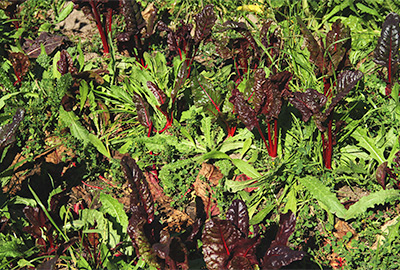
Chard has few antagonist plants in the vegetable garden, and does well when planted with many other vegetables. Onions, other alliums, and kohlrabi are traditional companions. Planting chard sparsely among more dense onions or other alliums may provide mild discouragement for slugs, snails, and insect pests. Green-leafed and white-ribbed varieties of chard may grow large enough to shade smaller plants.
Nutrient/Amendment/Fertilization Needs/Tips
Chard prefers fertile soil with sufficient nitrogen, phosphorous, potassium, sulfur, magnesium, and organic matter, but performs well in many less-than-ideal or even poor soils. Nitrogen is often the limiting nutrient in growth of chard. GardenZeus recommends adding nitrogen as a soil drench in the form of diluted urea or a cup of chicken manure diluted in 4 gallons of water (half cup if fresh manure) and mixed thoroughly after seedlings are 2 to 3 inches tall and about twice per month thereafter when actively harvesting outer leaves. Overly rapid plant growth from too much nitrogen may encourage insect infestation.
Mulching
Use 1/4 to 1/2 inch of fine mulch for small starts under 4 inches in height; increase to 1/2 inch or more of fine-to-medium mulch after plants are 6 to 10 inches tall.
Pruning/Cutting Back/Pinching/Separating
GardenZeus generally recommends harvesting outer leaves of chard as needed, which allows the plant to produce new leaves over an extended period from the growing point at the plant's center. Cutting back the flower stalk or inflorescence of a chard plant may extend the harvest of leaves by about 10 days to several weeks.
Propagating
From seed. GardenZeus generally recommends open-pollinated, untreated, organically grown seeds.
Container Gardening
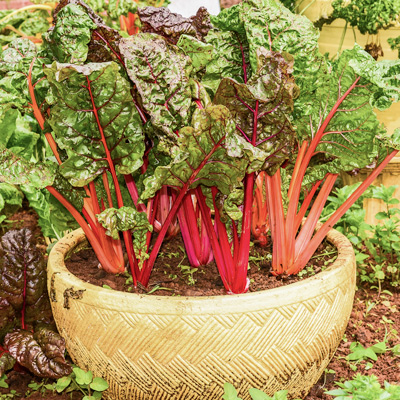
Chard adapts well to container gardening; all varieties are suitable for growing in containers. Start seeds directly outdoors in containers during your planting season. GardenZeus recommends 5-gallon or larger nursery pots or other containers with at least 10 to 12 inches of soil depth. Thin to 1 to 2 plants per 5-gallon pot if growing chard to full size, or a few plants per pot if harvesting entire plants before maturity.
See GardenZeus Tips for Container Vegetable Gardening for general information and tips about growing vegetables and herbs in containers.
Seasonal Care
Start seeds directly outdoors during your area's planting season. Biointensive and skilled gardeners may succeed with starting seeds indoors a few weeks early.
Red and multi-colored varieties are less tolerant of heat and should be grown during cool to warm weather only. Green-leafed, white-stalked varieties may tolerate hot weather and continue to yield once established, especially if shaded during hot afternoons. Be sure to keep chard plants well-watered during hot weather; water stress is a primary cause of early bolting. Green-leafed and white-stalked varieties of chard can provide a steady, year-round harvest of leaves in areas with little or no winter frost, but may bolt prematurely during hot weather, cold weather, or dry soil conditions.
How to Harvest
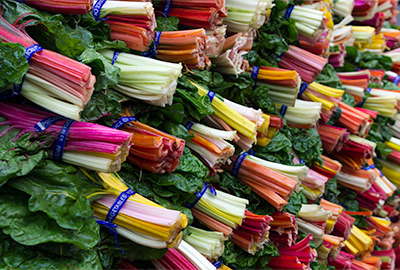
Whole plants can be harvested at desired size, from 3-inch tender starts to maturity at 1 to 3 feet or more in height. Cut off the entire plant low on leaf stalks or at the root crown using a sharp knife or garden scissors.
GardenZeus recommends harvesting outer leaves of chard as needed, which allows the plant to produce new leaves over an extended period from the growing point at the plant's center, for as long as 1 or 2 years in mild-winter areas for some chard varieties. Chard plants will produce a larger yield sooner if you wait to harvest individual leaves until plants are about 16 inches tall, but you may prefer to harvest selectively and enjoy tender young leaves anyway. Expert Darren Butler recommends never cutting more than 10% to 20% of any single plant during a given harvest period of 1 to 2 weeks. Cut the stalks or midribs of the largest, outermost leaves near the soil or as low as possible with inevitable crowding from other midribs, using a sharp knife or garden scissors.
Harvesting Tips
Try planting extra seeds and harvesting leaves or entire plants when they are small and tender, from 4 to 10 inches in height.
New leaves develop from the center of the plant; generally it's best to harvest the outermost (older) leaves, but feel free to leave ragged, yellowing, or insect-chewed outer leaves to die back on their own, and cut the more luscious newer leaves as desired. Unless diseased or infested, it is best to leave the older, unattractive leaves on the plant for photosynthesis needed to grow new leaves. Chard is also able to transport some nutrients from older leaves into new leaves.
What Commonly Goes Wrong
Chard is a relatively trouble-free vegetable.
Bolting is most common in chard after frosts, hot weather, or periods of soil dryness. Try cutting off flower stalks to extend harvest of leaves by 10 days to several weeks.
Bolting: Greens and other plants from which we eat leaves, stems, or roots may begin to go to seed as a result of water stress, repeated wilting, hot or cold weather, disease or insect infestation, other stresses, or naturally as the result of their annual or biennial reproductive cycles. Leaves, roots, and other edible plant parts usually turn tough, bitter, and/or unpalatable after vegetable plants begin to flower. There is nothing that can be done to reverse or stop bolting once it begins. Harvest may be extended for some plants, such as chard, and less-so for lettuce and arugula, by cutting off flower stalks as soon as they appear.
Chlorosis is iron deficiency that appears as lightening or yellowing between veins on older leaves and/or pale-green or yellow new leaves. Affected leaves will never return to normal because iron is not a mobile nutrient, meaning that it cannot be relocated within a plant. Alkaline city water and alkaline soils are common causes of chlorosis. Iron becomes decreasingly available to plants when soil pH is above 6.0, and is mostly unavailable at pH of 7.0 and above. Applying chelated iron can help temporarily but is not a long-term solution or cure, and chelated iron may rapidly become unavailable in alkaline soils. The best solutions are to encourage a thriving soil ecosystem that will naturally improve pH; provide acidity to soil by watering with diluted vinegar at proportions of about 1/4 to 1/2 cup of white vinegar in 2 gallons of water; or use an acidifying product such as pH Reducer.
Nitrogen Deficiency: Most leaves will appear light green, with yellowing of the oldest leaves, and with the newest leaves darker green as the plant relocates nitrogen for new growth. Nitrogen is often the limiting nutrient in the growth of vegetable plants. See the Nutrient/Amendment/Fertilization Needs/Tips field for each vegetable, or add nitrogen as a soil drench in the form of diluted urea or a cup of chicken manure diluted in 4 gallons of water (half cup if fresh manure) and mixed thoroughly. Be cautious not to add too much nitrogen, which may cause burned leaf tips. Overly rapid plant growth from too much nitrogen may encourage insect infestation.
Shallow Rooting: In alkaline, overly acidic, or compacted soils, vegetable plants may grow extremely shallow root systems with plants that appear vigorous and healthy until warm weather arrives and upper soil layers heat up, after which plants may wilt repeatedly, bolt, decline, or die rapidly. Break up compacted soil before planting, amend with compost, encourage a health soil ecosystem, maintain surface mulch, and water slowly and less frequently to encourage deeper rooting.
Slow growth, lack of vigor, small or stunted plants, production of few or small leaves, yellowing leaves, dried-out or folded edges of leaves, brown or dead leaf tips or edges: These common symptoms may result from soil pH that is too high or too low, compacted soil, alkaline soil, overwatering, underwatering, irregular watering, cold or hot weather, planting rootbound transplants, lack of soil nitrogen, other soil nutrient deficiencies, or a combination of these. May also be the result of too much sun, wind, or other environmental and abiotic factors. Burned leaf tips may also result from overfertilizing, sodic soils, or soluble salts in soils.
Not a Problem
Chard is a favorite of many garden pests, especially when leaves are young and tender. You may find that chard leaves tend to be mildly-to-severely bug-eaten by the time you're ready to harvest, especially during warm-to-hot weather.
See How Squeamish Are You About Bugbitten Greens? for GardenZeus expert Darren Butler’s meditation about eating leaves that are preapproved by gastropods and the insect kingdom.
Common Diseases
Damping Off: If seedlings fail to emerge or starts die quickly, damping off is a likely cause. It’s caused by a variety soilborne fungi and fungus-like pathogens, most commonly Pythium, and occurs most often in cool, compacted, wet soils. Typical symptoms of infection include seeds that rot before they germinate, young sprouts that are mushy or decayed, and starts that die rapidly after they emerge. Start seeds in well-drained soil at a time when temperatures are warm, or under whatever conditions are needed to encourage rapid germination and initial growth of seedlings. If problems persist, sprout seeds indoors in a covered glass dish before planting, or sterilize soil mixes prior to starting seeds.
Mildews: Powdery and downy mildew appear as a whitish circles or whitish layers on the upper or lower surfaces of leaves, yellowing or dead spots, or pale or yellow angular leaf sections, and may be mistaken for other problems, such as nutrient deficiencies. Avoid wetting foliage when watering. Some mildews can be discouraged using a nontoxic homemade spray of one tablespoon each of baking soda and tea tree oil per quart of water, shaken vigorously and regularly as applied via spray bottle. Mildews are often difficult to control and are best managed through prevention and good cultural practices, such as planting resistant varieties, planting in areas with good air circulation, keeping foliage dry, less-frequent irrigation, encouraging biologically active "living" soil that will support strong plant immune systems, and rotating crops. Mildews are often not fatal and chard may produce reasonable yields of fresh uninfected leaves despite ongoing infections on older leaves.
Root Rot: Various bacteria and fungi may cause rot and kill plants, especially in wet soils. Dry out soils, encourage a healthy soil ecosystem, and avoid planting the same vegetables and their relatives in the same area for at least 1 to 3 years after difficulties with disease.
Common Pests
Common insect and gastropod pests of chard include aphids, cabbage worms, cutworms, earwigs, flea beetles, grasshoppers, leafhoppers, leafminers, potato bugs, slugs, snails, spider mites, and whiteflies.
Common animal pests of chard include birds, deer, gophers, and rabbits.
Special Care
For most of its long history prior to being a cultivated vegetable, chard was a wild beet; it performs best in soil conditions favored by root crops. Try giving it loose, uniform, deep, fertile soil free of obstructions, with uniform soil moisture, and with sufficient nitrogen, and watch the show as it grows to twice or three times its expected size, with huge leaves that can grow to more than 14 inches long and 10 inches wide.
Special Info
Opinions differ about taste of different chard varieties. Some gardeners find that they prefer the taste of certain varieties over others, while other gardeners find no distinctive difference. Many cooks find that the red and multi-colored varieties have a milder flavor than the green-leafed, white-stalked varieties.
Sustainable Landscaping Tip
In reasonably fertile soil with normal rainfall, chard can thrive over winter in areas with little or no frost. Irrigate or water your planting area to flush weed seeds, then seed chard directly or broadcast seeds in fertile soil during cool weather when rains are forecast. Chard competes well with many weed species and can be successfully grown in wild, weedy areas as long as soil is reasonably fertile. Monitor seedlings every several days during dry periods, and less often once established. Mulch well or seed a drought-tolerant living mulch such as purslane. In years with sufficient winter rainfall, you can enjoy chard all winter and into spring or summer with very little effort or maintenance.
Advanced Tip
Use caution with saving seeds. Chard will cross-pollinate with beets to produce inferior plants in the following generation. It has been expert Darren Butler's experience that chard seed-quality is reasonable to good if there are no beets or other chard varieties flowering at the same time nearby. If saving seeds, time plantings of beets and chard in your own garden so that they are not in bloom at the same time, which may be easier than it sounds as beets are normally harvested and the roots stored at cold temperatures for seed saving in your zone. Chard is unpredictable about when it flowers; while beets generally flower promptly after being grown for a season, harvested, and stored for few weeks at cold temperatures, then replanted.
Chard can be effectively transplanted within the first few weeks after germination; this is generally recommend for skilled biointensive gardeners and experienced gardeners who are willing to monitor seedlings closely.
Preservation, Storage, and Use
Chard is best eaten immediately after harvest, but will store in the refrigerator for several days to a week or longer. You may wish to stand up stalks in a glass or jar with water, bind leaves together, and/or cover with a produce bag in the refrigerator to maintain crispness.
Chard is sensitive to ethylene gas; take care to place it far away from ethylene-producing fruits and vegetables in your refrigerator. See The GardenZeus Guide to Ethylene-Sensitive Vegetables for more information about ethylene and ethylene-sensitive vegetables.
If you are blessed with a large harvest of chard, consider freezing. See The GardenZeus Quick and Easy Guide to Blanching and Freezing Vegetables and Herbs for more information.
Chard’s numerous uses and colors make it an interesting culinary companion and favorite of many kitchen gardeners. It may be enjoyed raw in fresh salads and sandwiches or sautéed, boiled, braised or steamed. It makes a good substitute for spinach and other greens that won't tolerate your zone's summer heat, and is often used in Mediterranean dishes. While stalks may be too tough for some palates for fresh eating, you may be more comfortable using them as a chopped-celery substitute in soups, salads, and other dishes. The younger and more-tender stalks can be used as fresh-celery replacements, such as for healthy nut-butter-filled snacks for kids.
Chard provides enormous nutritional value, containing high levels of vitamin A, vitamin C, vitamin K, manganese, zinc, magnesium, iron, calcium, and potassium. It provides an array of nutrients that may be helpful for maintaining bone health or healing bone injury.